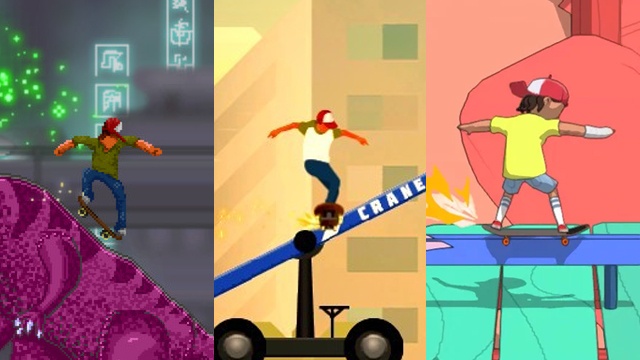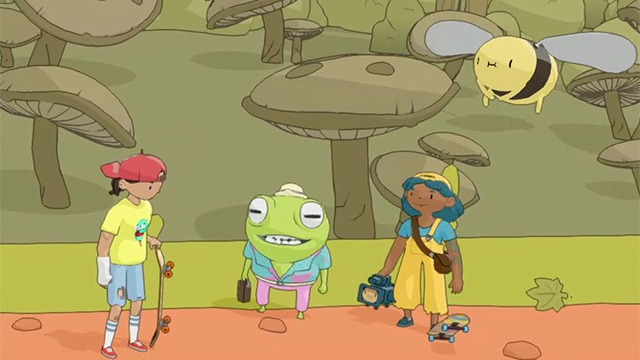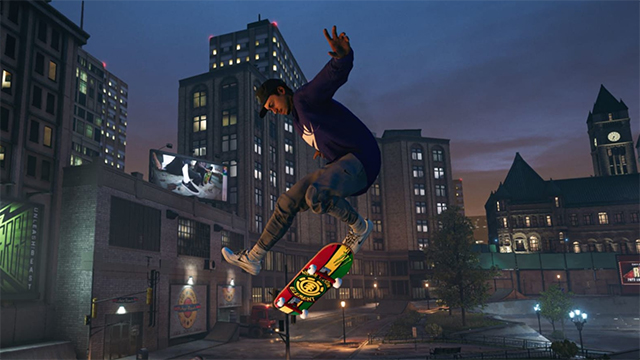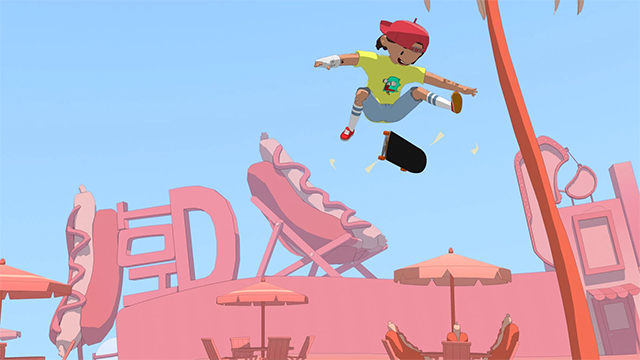OlliOlli World is shaping up to be a fantastic installment in the skateboarding series. Roll7 is focusing more on a more casual experience while also not diminishing any of its many skill-based mechanics. A lot of this comes from Co-CEO Simon Bennett and Creative Director John Ribbins. Both are skateboarders, too, and their views of the sport have changed since making the first OlliOlli way back in 2014.
Senior Gaming Editor Michael Leri recently spoke with both of them to talk about this change in mentality, the series’ constant changes in art style, the move into 3D, those Tony Hawk’s Pro Skater remasters, and more.

Michael Leri: All three of the OlliOlli games have such unique art styles from one another. Why change it so radically from OlliOlli 2 to OlliOlli World and then, zooming out, why have such different art styles for every game?
John Ribbins: Between the first two games, we pushed the art as far as we could comfortably do it with the skills that we had. Pixel art was what we could do when we made the first game and I am really proud of the pixel art we did. I am proud of the amount of effort it took to hand animate and draw every skate trick in pixel art.
And with OlliOlli2, I don’t think we were comfortable with the idea of moving into 3D, but we could definitely do higher-res art and I thought we could make it illustrative instead of pixel art because it was not like it was getting played at that point but there were a lot of pixel art games.
You can say it was getting played out a bit. It was getting played out a bit.
Ribbins: It was getting played out a little bit. How can we stand out? We should try and push it a little bit and do something illustrative instead. Obviously, we have had a really long break. We have done 3D games since then. We cut our teeth and skilled up as a studio. Even when we did OlliOlli2, we had these conversations where we were like, “Ah man, if it was 3D, we could just rotate the guy!” That kind of stuff is what we’ve always wanted to do.
Thanks to the skills and expertise we got with the backing we got from working with Private Division, we felt we had to move into 3D. It was the next step in the evolution of the game to be able to have 3D environments, which affords us loads of cool stuff. And for the players, it affords them to do more with tricks.
We built OlliOlli for the kinds of players that look for all the secrets. And while it’s awesome to have conversations like that with someone who has done everything, anecdotally, a lot of the conversations were of people who loved it but didn’t get past the first world. And we spent so much time and effort crafting all of this other stuff that people never got to see because we made it super hard.
So one of the fundamentals of coming back to this was that we wanted to make a game where most of the people see most of the hard work that we put into the thing. The fact that we moved to 3D and the levels can be more complex and have more routes and you can find different ways through them means we can still have these routes where you can go off and find the super, super difficult stuff — we will still give you that challenge if you want it — but it also gives us the freedom to make a game that’s as much about exploring that world and enjoy exploring it without having to be a pixel-perfect ninja warrior to get through.

One of the routes unlocked a side mission that was a circular level. Are they all like that or are they all different takes on the game’s core mechanics?
Ribbins: All of those levels where you meet an NPC in the world were all an opportunity for us to do something that’s a total break from how the rest of the game works. Those characters repeat and usually have a running theme to the levels they make, but they are an opportunity for us to do something weird. Like you can have a race against someone or a looping level with a score challenge.
When we prototyped the game, we thought they were cool but knew it couldn’t be the whole game because it’s too different from OlliOlli but it could be really cool as an individual set piece thing. So those are the opportunities for us to do those set pieces.
As you get deeper into Radlandia, the number of paths you can optionally swerve off into get a lot bigger and so you’re not necessarily going to find an NPC at the end of all of those, but some of those paths may just be considerably harder than the main path that you can take to get to the end.
But those might give you more points?
Ribbins: Potentially, yeah. Like you can loop through some sections if you have a high enough skill.

It’s been six years since OlliOlli2. Why return to OlliOlli instead of making a new kind of game?
Simon Bennett: When we originally made OlliOlli, John and I had been working together for years at the company prior to this making educational games. We were doing a ton of stuff but one of the things that brought us together was a love of skateboarding and skateboarding culture but we never skated together. I was in my mid-20s when we met and I stopped skating around 18 or 19.
And then we made OlliOlli and in doing so, we wanted to make some merchandise and promotional skateboards so I thought I should brush up on my old Alien Workshop board that’s in my attic somewhere. I grabbed it and we started doing ollies in the office and going out for a skate at lunch and I was slowly falling in love skateboarding again through the game that we were making. It became this love affair that, for me, sort of ended up with finding weird skatecraft like weird longboards, surf trainer skateboards with weird and funky front trucks that are super dangerous, and electric skateboards that I’ve spent far too much money on over the years.
And John used to be a sponsored skater and therefore can do loads of insane tricks and is very good at skateboarding and ended up getting back into it very seriously again and became probably like the biggest thing outside of work that he did. That love affair with those different elements of skateboarding came from the game. I think it was pretty clear that we would always talk at the pub and be like, “If we did OlliOlli again, we’d do X or Y.” There have been so many conversations over the years and so many would say they would happily fund the OlliOlli game and we said we’d do it when we’re ready. Literally like two-and-a-half years ago, we were like, “Now is the time. This is when we need to do it.”
There was no, [puts on businessman voice] “The market is ready for this game now” or “It is important that we revisit the franchise.” It was more that we had so much that we wanted to do that we discussed over the years and it was so right to do now before our knees descend into absolute mediocrity and we can never skate again.
This is our love letter to skateboarding. This is something that is art imitating life imitating art. That’s the thing that’s what is exciting to us. This is the OlliOlli that we never knew we would even be capable of making but we always wanted to make. It’s more beautiful and more amazing than any of us would have imagined.
Ribbins: It is very nice for Simon to say I am very good at skateboarding. I disagree in the grand scheme of skateboarders. Fundamentally, in the gap between OlliOlli2 and now, the thing for me that changed was not caring about being good at it anymore and being a thing that’s just fun. It’s mainly social. It’s like you meet some cool people who share the same interests and have some fun doing it. That’s definitely something that’s bled through and influenced what we are trying to do in the game.
The very first game I tried to make when I was 14 was a skateboarding game that looks a bit like the original OlliOlli. Thinking about that game as a kid and when we started, it was like a classic skateboarding thing of, “I want to go pro.” And it’s really hard and you have to land your tricks and it is going to be difficult.
And coming back to this one was more like, “Well, it can be very difficult if you want it to be.” And you can spend seven hours trying to do pretty hard tricks. But you can also hang out at the car park curb with some friends and just do slappy grinds on it for a couple of hours and that’s super fun.
We’re trying to instill a bit of that vibe of skateboarding in this game as well. It’s just a rad thing to do with your friends. Simon and I aren’t that good but we can go on a skate road trip. We wanted some of that to bleed into this and it’s a game about going on a road trip with your friends across this island and exploring it and meeting new people.

So was that the impetus of adding a posse?
Ribbins: Yeah, for sure. We wanted to bring heart to the game. The first two were a really solid set of mechanics. And the scope and the time we had with the game let us make a game with a really solid set of mechanics. And in terms of evolving that and growing that into a fuller experience, we were like, “Let’s make it a proper world.” Like it had to be a world that we thought about beyond having five genres of movies that we could base levels around. So we came up with a reason for each of the biomes and why they are there and who lives there.
The second game brought in some new mechanics like manuals and grind switching. This one also adds stuff like grabs or wall riding. How do you approach expanding the Tricktionary for a game that’s essentially like a sport where the rules don’t change much at all?
Ribbins: Simon has wanted grabs since the first game. Partly we haven’t had the scope to do it because we would have had to animate every single part of the rotation in 2D. Partly it was because I didn’t want to put grabs in. And then we put grabs in when we were prototyping it and they were awesome and Simon was right all along.
Bennett: [laughs] Yay! I was right about something. It has to be meaningful. Anything that we make, we start with the feel and flow. If you tack something on and it doesn’t feel meaningful or visceral or powerful to use, then it doesn’t go in. Lots of things were prototyped. But separate to that, it’s about what it actually gives the player. Does it allow them to do anything with the space?
With grabs, we add a really exciting mechanic that helps you traverse later on in the game. There are firecrackers that help you expand your combo by literally slapping down a series of steps. In adding them, the crucial part is that they are mechanically succinct and compatible with the idea of traversing and they just don’t feel tacked on. A lot of time was spent during prototyping to make sure what we had was cohesive.
The big difference is that you’ll be introduced to all of these new elements throughout the entire experience as opposed to right off the bat. If we gave you everything in one big tutorial, you’d be in a tutorial for like two hours.
Ribbins: We had a lot of mechanics like revert manuals in OlliOlli2 that required a lot of player skill to use. Whereas with OlliOlli World, we’ve tried to have a lot more traversal mechanics that would cover the beginning or entry point of combos. Like wall rides and firecrackers are all things that give you more breadth of what you are doing on just a basic level instead of a really high-level skill. There is still a lot of high-level stuff you can do. But we’re trying to have more things that more people can engage with. Overall, it gives you more variety in how you play a level.

What did you think of the Tony Hawk remasters Activision put out last year?
Ribbins: They were rad. I thought they did a really good job of updating it. It was really cool they included a bunch of more contemporary skaters. It’s super cool that Steve Caballero is in the game and it’s Steve Caballero now. They went and scanned him now and didn’t just make young Steve Caballero. But they also included more contemporary skaters like Leticia Bufoni.










